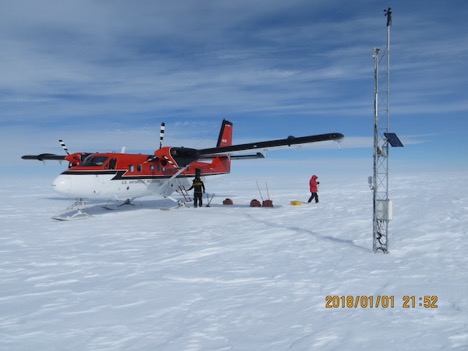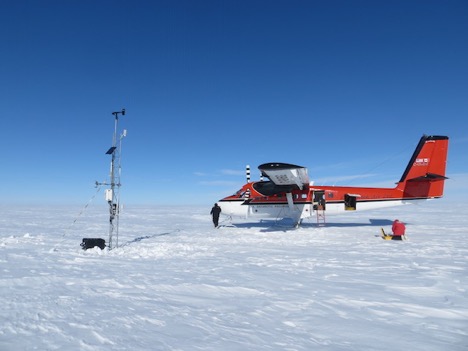Harry AWS, 2 January
On 2 January, we took an Otter to Harry AWS. For this site, we wanted to install a boom with an ADG sensor and move the solar radiation sensor currently installed at Harry onto said boom. The pressure sensor has been acting oddly at times, so we wanted to check the wiring on that. We also wanted to raise the station if needed. Before going, we weren’t sure if we needed to add another tower section or not. As it turned out, we did not need to add a tower section! A pleasant surprise. The battery box was only buried a few inches, so digging that up was easy.
It was quite windy for the duration of our visit, with sustained winds of 15 to 20 knots. Fortunately for us, the temperature was quite warm (around -7 C) so despite the winds, it was still bearable working conditions.
Marian and I dug out the power system then worked on doing any necessary maintenance to instruments on the tower. There wasn’t any issue found with the pressure sensor, so we are unsure why it would occasionally have bad readings. We raised the lower temperature sensor, enclosure, and solar panel. We installed the boom with the ADG and solar radiation sensor as well. Troy noticed that the station was leaning slightly, so we used a cargo strap to function as a guy wire and hopefully prevent any further leaning.
Austin AWS, 3 January
Flying two days in a row! We were very excited to get out to Austin as this was our highest priority site. We stopped receiving transmissions from the site in March 2017, and our hypothesis was that was caused by a failure with the fuse box in the power system which then shut the AWS down. Before the transmission failure, we noticed from the ADG measurements that the station was getting buried very quickly. We knew that we had a long day of digging ahead of us, but if we couldn’t visit Austin this year we were worried that it would get buried by the next time we could visit.
Austin is also a tough site because it is one of the furthest AWS from WAIS which means more time flying, more fuel, and more of a chance that the weather could turn either at Austin or at WAIS, preventing us from going. The forecast at Austin for that day called for clear skies but fog in the vicinity. Another one of our sites, Evans Knoll, was clear, so our plan of action was to fly to Austin and if conditions were too poor, we would head to Evans Knoll. As it turned out, the weather was gorgeous at Austin for our entire visit; clear skies and low winds (and relatively warm temperatures around -10 C).
Austin was as buried as we were fearing, but we were very happy that the enclosure was still above the surface. This allowed us to check the datalogger right away, but as expected, it was not powered on.
We began digging down to the power system buried about 8 feet below the enclosure. We also needed to dig out the ADG/solar radiation sensor boom and the lower temperature sensor that was mounted on the opposite side of the enclosure.

The two pits at Austin, with the power system pit in the foreground. This may be where we just reached the top of the box.
After a little over an hour, enough had been dug out for Marian and I to start removing the instrumentation and install the new tower section. As opposed to Kathie, we were prepared to use a cargo strap to help us get the tower section on. And it worked very well. Given the amount of accumulation at Austin, we decided to put a 7-foot and a 5-foot tower section on, to raise it 12 feet. This will hopefully make the next visit a little easier, as the only thing that will hopefully be buried is the power system.
About halfway through, we were welcomed with an unexpected visitor… a skua!
It’s always strange seeing wildlife in the middle of the continent. There’s almost literally nothing but snow and ice for hundreds of miles. It’s amazing that an animal could make it this far. We think that it got here by accident, though, and that it probably won’t make it back to the coast, or a place where it can find food. We were hoping for the best for the little guy!
After that interesting distraction, we finished up with the station raise to make Austin look like new again.
One bummer that we didn’t learn about until a couple days after our visit is that the real-time transmissions are not working. We are not sure whether it’s simply a loose cable connection or if there is something wrong with the Argos transceiver. We did verify that the station was powered on and collecting data when we left, so at least we will have the data card collecting the data in the meantime.
Also, as a bonus, right before we left we noticed some fata morgana on the horizon. This is a mirage effect caused by cold air at the surface. It tends to make things look taller than they are. You can see this effect right on the edge of the horizon in the picture below.
Cheers,
Dave Mikolajczyk











